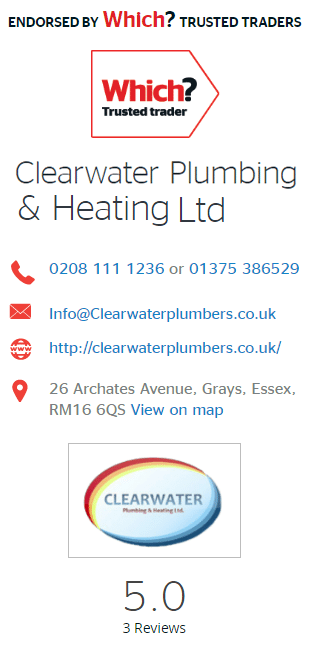Underfloor Heating Basildon
Call 01268 350 025
Welcome to Clearwater Plumbers. We install, service and repair Underfloor Heating systems in Basildon.
- Underfloor Heating Installation, Service & Repairs Free no-obligation surveys & quotes
- Insured, Gas Safe registered engineers Types Of Underfloor Heating
Types Of Underfloor Heating
There are two types of underfloor heating, Wet and Electric, and we fit them both.
Wet (or Hydronic) Systems
Wet systems use a network of pipes laid under the floor through which warm water is circulated. The installation involves connecting the pipes to a boiler or a heat pump. This system is more cost-effective and often recommended for larger areas, extensions or new-build projects.
Electric Systems
Electric systems use electric coils placed under the floor to generate heat. The installation involves installing heating mats with electric wires on the subfloor before applying the final flooring material. It’s relatively easier and cheaper to install, especially in small areas or retrofit projects, but is more expensive to run than wet systems.
Deciding Between Wet & Electric Underfloor Heating
Wet & Electric Underfloor Heating Systems are excellent for heating homes and spaces, offering distinct advantages over traditional radiators. When deciding whether to opt for a wet or electric system, you need to look in detail at the characteristics of each system to determine which is best for your situation.
Wet Underfloor Heating Systems
Wet underfloor heating systems offer a comfortable and efficient way to heat homes and are increasingly popular in newly built homes and for major renovations.
- How It Works: A wet underfloor heating system is connected to your boiler, which heats water. Hot water from the boiler is pumped through a network of pipes under the floor surface. As the heat rises, it evenly warms the room from the floor upwards.
- Installation: The installation involves laying pipes within the subfloor. The pipes are typically made of durable materials like cross-linked polyethylene (PEX). These pipes are usually embedded in a screed (a layer of concrete mix) fitted between joists or placed within pre-built panels designed for underfloor heating. The entire system is then connected to your boiler.
- Efficiency: Wet underfloor heating is known for its efficiency and even heat distribution. It operates at lower temperatures than traditional radiators, making it more energy-efficient and cost-effective in the long run, especially when heating large areas or whole-house heating.
- Flooring Compatibility: This system is compatible with various floor types, including tile, stone, wood, laminate, and carpet, provided the carpet’s thermal resistance does not inhibit heat.
- Thermostatic Control: Like other heating systems, it can be controlled thermostatically. This allows room-by-room temperature control, making it a flexible and efficient heating solution.
- Benefits: The primary advantages include heat distribution, no cold spots, space-saving (no need for radiators on walls), and a more comfortable ambient room temperature.
- Considerations: The installation is more invasive and expensive than electric underfloor heating systems, making it more suitable for new builds or major renovations. The system can also raise the floor level slightly.
- Maintenance: It requires minimal maintenance, but regular check-ups are recommended to ensure the system operates efficiently and prevent potential issues.
Electric Underfloor Heating Systems
Electric Underfloor Heating offers a convenient and relatively easy-to-install option for adding warmth to specific areas in a home, particularly where retrofitting is required.
- How It Works: Electric underfloor heating systems consist of thin heating wires or mats installed directly under the floor surface. When electricity passes through these wires, they heat up, warming the floor and the room above.
- Installation: Compared to wet underfloor heating, the installation process is relatively simple. Heating mats or cables are laid out on the subfloor or within a layer of self-leveling compound. This system can be installed under various types of flooring, including tile, stone, laminate, and some types of wood. It’s particularly popular for renovations because it adds minimal height to the floor.
- Control and Efficiency: Electric systems are controlled with a thermostat, often programmable for better energy management. While the cost of running an electric system can be higher than a wet system, its efficiency can be maximised by using an insulating layer beneath it to prevent heat loss downwards.
- Benefits: The main advantages include ease of installation, suitability for retrofit projects, and the ability to heat up more quickly than wet systems. It’s also ideal for heating small areas, like bathrooms or kitchens.
- Considerations: Electric underfloor heating is generally more expensive to run than wet systems, making it less suitable for large areas or as the primary heating source for a whole house. However, it’s ideal for small areas or supplemental heating.
- Maintenance: Electric underfloor heating systems require very little maintenance. However, if a problem does occur, it can be more challenging to access and repair the heating elements since they are embedded beneath the floor.
Free Underfloor Heating Survey
In short, wet systems are better for larger areas and whole house heating, while electric systems are better for smaller areas or as supplemental heating. An example of supplemental heating is installing electric underfloor heating in a bathroom and using it in conjunction with a radiator.
Every home and situation is different, so we offer free, no-obligation underfloor heating surveys and quotes from one of our experienced gas-safe registered engineers. Our engineer will evaluate your home and space, consider your requirements, answer your questions, and offer the best solution, along with a written no-obligation quote.
Servicing
Periodic servicing maintains the efficiency and performance of the underfloor heating system. This might include checking and adjusting the boiler or heat pump, inspecting the manifold, and ensuring the correct water pressure and flow rates for wet systems. For electric systems, it involves checking the thermostat, timers, and the integrity of the electric mats or cables.
Repairs
Repairs will be necessary if a problem arises, such as uneven heating, no heating, or issues with the controls. Common repairs we undertake include:
- Pipe or Cable Damage: Fix leaks in wet hydronic systems or breaks in the electric heating elements.
- Manifold Issues: The manifold may need repairs or adjustments in wet systems.
- Thermostat Problems: Replacing or repairing faulty thermostats or control systems.
- Air in the System: In wet systems, air can get trapped in the pipes, creating cold spots and requiring bleeding.
Contact Us
If you require Underfloor Heating installation, service, or repair, please call 01268 350025 or email us.








